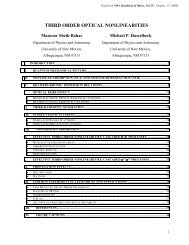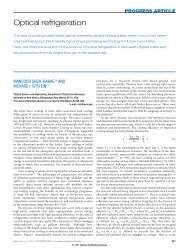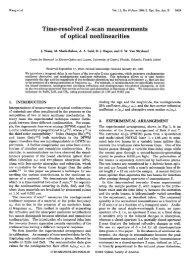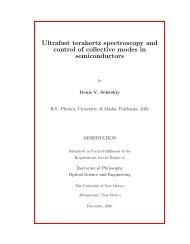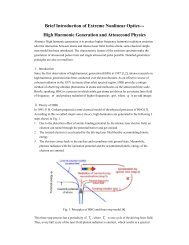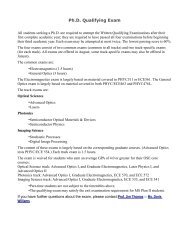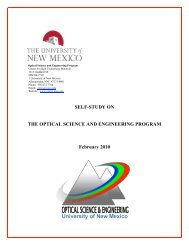Semiconductor Saturable Absorber Mirror (SESAM)
Semiconductor Saturable Absorber Mirror (SESAM)
Semiconductor Saturable Absorber Mirror (SESAM)
You also want an ePaper? Increase the reach of your titles
YUMPU automatically turns print PDFs into web optimized ePapers that Google loves.
Instructor: Prof. Mansoor Sheik-Bahae<br />
<strong>Semiconductor</strong> <strong>Saturable</strong> <strong>Absorber</strong> <strong>Mirror</strong><br />
(<strong>SESAM</strong>)<br />
Yule Zhang & Yanrui Zhao<br />
List of content:<br />
1. General Introduction<br />
2. Overview of Different <strong>SESAM</strong> Designs and Parameters Control<br />
3. Q-switched Mode-Locking vs. CW Mode-Locking<br />
4. <strong>Semiconductor</strong> <strong>Absorber</strong> in Ring Lasers<br />
5. Conclusion and Future work
1. General Introduction<br />
Since 1992, semiconductor saturable absorbers have become the important components in the compact<br />
mode-locking solid-state lasers [1]. This invention offers the possibilities for passive pulsed solid-state<br />
laser systems, extending from Q-switched pulses in the nanosecond and picosecond regime to modelocked<br />
pulses from 10’s of picoseconds to sub-10 fs. In this report, we will review the theory and designs<br />
of semiconductor saturable absorber mirrors (<strong>SESAM</strong>) and focus on some specific topics such as<br />
structure design of the <strong>SESAM</strong> and parameters control, Q-switched mode-locking vs. CW mode-locking,<br />
and finally talk briefly about its extended application in ring lasers.<br />
Mode-locking is one of the most popular techniques<br />
to obtain ultrashort pulsed lasers. Lasers with multigigahertz<br />
repetition rates are key components of many<br />
applications. They are used in high-capacity<br />
telecommunication systems, photonic switching devices,<br />
and optical interconnections and for clock distribution<br />
etc. Figure 1. shows the history of mode-locking<br />
technology since 1960 [2].<br />
A saturable absorber is a material that has decreasing<br />
light absorption with increasing light intensity. The key<br />
parameters for a saturable absorber are its wavelength<br />
range (where it absorbs), its dynamic response (how fast<br />
Fig. 1. History of mode-locked pulsed laser technology [2]. it recovers), and its saturation intensity and fluence (at<br />
what intensity or pulse energy density it saturates).<br />
<strong>Semiconductor</strong> materials, however, can absorb over a broad range of wavelengths (from the visible to the<br />
mid-infrared). We can also control their absorption recovery time and saturation fluence (typically 1 to<br />
2<br />
100mJ<br />
/ cm ) by altering the growth parameters and device design. The <strong>SESAM</strong> is a saturable absorber<br />
that operates in reflection, thus the reflectivity increases with higher incoming pulse intensity [3].<br />
During the past decade, the device design, fabrication process and long-term device reliability have been<br />
significantly improved. There are <strong>SESAM</strong> designs that can cover wavelengths from 1600<br />
nm, pulsewidths from femtoseconds to nanoseconds, and power levels from milliwatts to >100 watts.<br />
Fig. 2. a) How does semiconductor absorber work b) fundamental passive mode-locking models: i) passive mode-locking with a<br />
slow saturable absorber and dynamic gain saturation. ii) fast absorber mode-locking. iii) soliton mode-locking. [2]<br />
1
Fig. 2(a) shows how does the saturable absorber work. A semiconductor absorbs light when the photon<br />
energy is sufficient to excite carriers from the valence band to the conduction band [2]. Under conditions<br />
of strong excitation, the absorption is saturated because possible initial states of the pump transition are<br />
depleted while the final states are partially occupied. Within 60~300 fs of excitation, the carriers in each<br />
band thermalize, and this leads to a partial recovery of the absorption. On a longer time scale, typically<br />
between a few picoseconds and a few nanoseconds—the carrier will be removed by recombination and<br />
trapping. The presence of two different time scales can be rather useful for modelocking. The longer time<br />
constant results in a reduced saturation intensity for a part of the absorption, which facilitates self-starting<br />
mode-locking, whereas the faster time constant is more effective in shaping subpicosecond pulses.<br />
Therefore, <strong>SESAM</strong>s allow us to easily obtain self-starting mode-locking [2].<br />
As the low intensity part of the pulse will be absorbed, while the high intensity part will pass the<br />
material with little loss, which result in the compression of the pulse, i.e. the pulse becomes shorter and<br />
shorter when it passes through this saturable absorber. And fig.2.b) shows the three fundamental passive<br />
mode-locking models. : i) passive mode-locking with a slow saturable absorber and dynamic gain<br />
saturation. ii) fast absorber mode-locking. iii) soliton mode-locking. These three basic models show us<br />
the different pulses we will get, combining of different gain medium and absorbers [1].<br />
2. Overview of Different <strong>SESAM</strong>s Designs and Parameters Control<br />
<strong>Semiconductor</strong> saturable absorbers have the advantage that the relevant absorber parameters can be varied<br />
by several orders of magnitude. Thus semiconductor saturable absorbers offer significant improvements<br />
in performance compared with other saturable absorber. Now let’s go through various designs of<br />
<strong>SESAM</strong>’s, which achieve many of the desired properties. Fig. 3 shows four typical designs in historical<br />
order.<br />
Fig.3. Different <strong>SESAM</strong> devices. (a) High-finesse A-FPSA. (b) Thin AR-coated <strong>SESAM</strong>. (c) Low-finesse A-FPSA. (d) D-SAM [1]<br />
Fig.3(a) shows the first intracavity <strong>SESAM</strong> device, which was the antiresonant Fabry-Perot saturable<br />
absorber (A-FPSA) [1]. It has a rather high top reflector. Thus it is called the high-finesse A-FPSA. The<br />
Fabry-Perot is typically formed by the lower semiconductor Bragg mirror and a dielectric top mirror, with<br />
a saturable absorber and possibly transparent spacer layers in between. The thickness of the total absorber<br />
and spacer layers are adjusted such that the Fabry-Perot is operated at antiresonance. Operation at<br />
antiresonance results in a device that is broad-band and has minimal group velocity dispersion. The top<br />
reflector of the A-FPSA is an adjustable parameter that determines the intensity entering the<br />
semiconductor saturable absorber and, therefore, the effective saturation intensity or absorber cross<br />
section of the device.<br />
2
High finesse antiresonant Fabry-Perot saturable absorber (A-FPSA) device was the first intracavity<br />
saturable absorber that started and sustained stable CW mode-locking of Nd:YLF and Nd:YAG lasers in<br />
1992 [1]. It has been used to passively Q-switch microchip lasers, generating pulses as short as 56 ps.<br />
Femtosecond pulse durations τ p have been generated with Ti:sapphire (τ p =19fs), Yb:YAG (τ p ~500fs) etc.<br />
In the design of Fig.3 (b) AR-coated <strong>SESAM</strong>, the top mirror is replaced with an AR-coating. Using<br />
the incident laser mode area as an adjustable parameter, the incident pulse energy density can be adapted<br />
to the saturation fluence of the device. The AR-coated <strong>SESAM</strong> device can be viewed as one design limit<br />
of the A-FPSA with a ~0% top reflector. However, an additional AR-coating increases the modulation<br />
depth of this device and acts as a passivation layer for the semiconductor surface that can improve longterm<br />
reliability of this <strong>SESAM</strong> device. These AR-coated <strong>SESAM</strong>’s have started and stabilized a soliton<br />
mode-locked Ti:sapphire laser achieving pulses as short as 34 fs [1].<br />
Fig. 3 (c) shows the Low-Finesse A-FPSA. High finesse A-FPSA and AR-coated <strong>SESAM</strong> are the two<br />
design limits of the A-FPSA, while low-finesse A-FPSA is the intermediate design. It is achieved with no<br />
additional top coating resulting in a top reflector formed by the Fresnel reflection at the semiconductor/air<br />
interface, which is typically ~30%. The Bragg reflector does not play a key role in its operation and does<br />
not actually saturate. Thus, a metal reflector can replace the Bragg reflector. The limitations of lowfinesse<br />
A-FPSA devices include the bandwidth of the lower Bragg mirror, and potentially higher insertion<br />
loss than in the high-finesse A-FPSA. Pulses as short as 19 fs have been generated with the high-finesse<br />
A-FPSA compared to 34 fs with the low-finesse A-FPSA using the same lower Bragg mirror, for<br />
example. Replacing the lower Bragg mirror with a broad-band silver mirror resulted in self-starting 10-fs<br />
pulse and more recently pulses as short as 6.5 fs with a KLM-assisted Ti:Sapphire [1].<br />
D-SAM design is shown in Fig. 3 (d). The dispersive saturable absorber mirror (D-SAM) incorporated<br />
both dispersion and saturable absorption into a device similar to a low-finesse A-FPSA, but operated<br />
close to resonance. <strong>Saturable</strong> absorption and dispersion compensation in a semiconductor Gires-Tournoislike<br />
structure, called a dispersion-compensation saturable absorber mirror (D-SAM). The D-SAM, in<br />
contrast to the A-FPSA, is operated close to the Fabry-Perot resonance, which tends to limit the available<br />
bandwidth of the device. In Cr:LiSAF laser with this device, 160 fs pulses was achieved without further<br />
dispersion compensation or special cavity design. That was the first time that both saturable absorption<br />
and dispersion compensation have been combined within one integrated device [1].<br />
3. Q-switched Mode-Locking vs. CW Mode-Locking<br />
In many applications, such as telecommunication and laser gyroscope, we want the pulse sequence to be<br />
CW mode-locking instead of Q-switched mode-locking. From [3], they came to the conclusion that the Q-<br />
switched mode-locking will be avoided if the following equation can be satisfied [3].<br />
2<br />
E E E ΔR<br />
(1)<br />
p<br />
><br />
sat,<br />
L sat,<br />
A<br />
Where E<br />
p<br />
is the intracavity energy, defined by P<br />
int ra<br />
/ f<br />
rep<br />
, P int ra<br />
is intracavity average power and f<br />
rep<br />
pulse repetition rate. E ,<br />
is the saturation energy of the laser medium and it is proportional to<br />
sat L<br />
A<br />
eff , L<br />
/σ<br />
em,<br />
L<br />
where A<br />
eff , L<br />
is the average mode area inside the laser medium, and σ<br />
em, L<br />
is the emission<br />
cross-section of gain material. E ,<br />
is the saturation energy of the absorber, which can be represented by<br />
sat A<br />
Esat, A<br />
= Aeff<br />
, L<br />
Fsat,<br />
AΔR<br />
. A<br />
eff , A<br />
average mode area inside the saturable absorber, F<br />
sat , A<br />
saturation fluence of<br />
absorber and Δ R is the modulation depth of the saturable absorber.<br />
3
Fig. 4. Q-switch vs. CW Mode-locking [3]<br />
This equation is for the picosecond regime modelocked<br />
solid-state lasers. This stable condition is derived<br />
from the coupled rate equations assuming that the<br />
saturable absorber is fully saturated.<br />
Q-switching instabilities occur when the pulse energy<br />
is temporarily increased because of noise fluctuations in<br />
the laser, which then gets even further increased because<br />
of the stronger saturation of the saturable absorber. This<br />
has to be balanced by a stronger saturation of the gain [3].<br />
Stability means that the relaxation oscillation damped.<br />
The physical explanation of Eq. (1) can be, if the pulse<br />
energy rises slightly owing to relaxation oscillations, this<br />
pulse energy fluctuation first grows exponentially because of the stronger bleaching of the absorber.<br />
However, the increased pulse energy starts to saturate the gain. The laser is stable against QML if the<br />
gain saturation is sufficient strong to stop the exponential rise.<br />
Typically the <strong>SESAM</strong> is operated with an incident pulse fluence of about three to five times that of<br />
the saturation fluence. This saturation level of the absorber provides nearly the maximum modulation<br />
depth without damaging the device. Higher saturation also reduces the tendency for Q-switching<br />
instabilities because of thermal effects and two-photon absorption. From [5], it has been confirmed the<br />
presence of two-photon absorption in commonly used <strong>SESAM</strong>s structures by time-resolved differential<br />
reflectivity measurements. With pump-probe measurement confirmation that TPA is the dominant cause<br />
of the reflectivity drop observed in the saturation energy measurement. And they also theoretically<br />
predict that TPA will expand the CWML stability regime<br />
against QML. Fig. 5 illustrates the calculated stability<br />
regions in a logarithmic plot of the saturation power of<br />
the absorber versus the pulse energy, both normalize to<br />
the gain saturation [ ( I<br />
A<br />
AA<br />
/ I<br />
L<br />
AL<br />
) versus ( W / WL<br />
) ],<br />
where AA<br />
is the area of the spot focused on the absorber,<br />
I<br />
L<br />
is the saturation intensity of the gain, A<br />
L<br />
is the area<br />
of the beam in the gain medium and W is the pulse<br />
energy [5]. The solid line in Fig.5 indicates the instability<br />
boundary when TPA is not included; the inclusion of<br />
TPA reduces the instability boundary to the dashed line.<br />
In conclusion, TPA has increased the region for stable<br />
CWML and it can also enable a laser to reach a CWML Fig. 5. Calculated stability contours for a fast<br />
state that was not previously attainable. saturable absorber mode-locked laser. [5]<br />
.<br />
4. <strong>Semiconductor</strong> <strong>Absorber</strong> in Ring Lasers<br />
<strong>SESAM</strong> can also be used in the ring laser configurations. In Fig. 6 a), one cavity mirror is replaced by the<br />
<strong>SESAM</strong> to realize the mode-locking operation of the ring laser [6]. As the cavity length is long, two<br />
lenses (L) are used to obtain tight focus on the <strong>SESAM</strong>, so that high saturation of the absorber can be<br />
obtained. This configuration will result in bi-directional operation of a pulsed ring laser, which is the<br />
basic model for the laser gyroscope.<br />
To increase the flexibility of the setup, another cavity configuration is designed, as shown in Fig.6 b),<br />
4
instead of using the <strong>SESAM</strong>, the multi-quantum well (MQW) was redesigned and put in the cavity. Here<br />
the semiconductor absorber is not used as a mirror, but a lens. The MQW is put at the focal point of the<br />
telescope (formed by L1 and L2) in Fig. 6 b), to achieve a high saturation level. This setup is also used<br />
for the laser gyroscope, and the stable CWML is very much desired for measuring the beat note of the<br />
counter-propagation beams. By tightly focusing on the MQW, two photon absorption is the dominant<br />
effect that causes the lensing effect which result in the self-defocusing as the beam intensity increases.<br />
Fig. 6 a) <strong>SESAM</strong> in a ring laser as an end mirror; b) MQW used as saturable absorber inside the ring laser cavity.<br />
We can refer to the theory in part 3 and consider it using Eq. (1). The main cause of the Q-switched<br />
mode-locking here is the gain depletion. Then by putting an aperture to control the intracavity energy so<br />
that the gain will not be depleted. Combining the effect of self-defocusing and aperture, a balance region<br />
for the loss and gain can be reached which will result in stable CW mode-locking [7].<br />
5. Conclusion and Future work<br />
<strong>SESAM</strong>s have already become important components used to mode-lock a wide range of both solid-state<br />
lasers and fiber lasers. The application of <strong>SESAM</strong>s will be extended in more fields of solid-state lasers.<br />
They are aiming at higher power scaling of more than 100W of average power, more compact structure,<br />
and cheaper laser with even higher repetition rate [2].<br />
Reference:<br />
[1] U. Keller, K. J. Weingarten, F. X. Kärtner, D. Kopf, B. Braun, I. D. Jung, R. Fluck, C. Hönninger, N. Matuschek, J. Aus der<br />
Au, Invited Paper, "<strong>Semiconductor</strong> saturable absorber mirrors (<strong>SESAM</strong>s) for femtosecond to nanosecond pulse generation<br />
in solid-state lasers," IEEE J. Selected Topics in Quantum Electronics (JSTQE), vol. 2, 1996<br />
[2] U. Keller "Recent developments in compact ultrafast lasers" Nature, vol. 424, pp. 831-838, 2003<br />
[3] C. Hönninger, R. Paschotta, F. Morier-Genoud, M. Moser, U. Keller, "Q-switching stability limits of cw passive<br />
modelocking," JOSA B, vol. 16, pp. 46-56, 1999<br />
[4] M. Haiml, Grange, U. Keller “Optical characterization of semiconductor saturable absorbers” Appl. Phys. B, vol. 79, 2004<br />
[5] Two-photon absorption in semiconductor saturable absorber mirrors Thoen, ER; Koontz, EM; Joschko, M; Langlois, P;<br />
Schibli, TR; Kartner, LA Source: APPLIED PHYSICS LETTERS; JUN 28 1999; v.74, no.26<br />
[6] Vaclav Kubecek *a , Jean-Claude Diels b , Andreas Stintz b , Bidirectional operation of a ring diode pumped mode-locked<br />
Nd:YVO 4 laser, 2004<br />
[7] Thien Trang Dang, A. Guandalini, V. Kubecek, J-C Diels, “Diode Pumped Short Pulse Active Laser Sensors”, Proceedings of conference<br />
EUROSENZORS XVI, www.eurosenzors.cz, paper TP 59, 40-41, Czech Technical University, Prague 2002<br />
5


